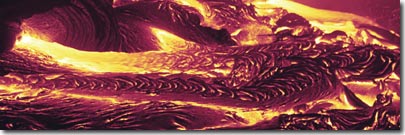Into the Future
By Gino Segrè

The following is excerpted from A Matter of Degrees—What Temperature Reveals about the Past and Future of Our Species, Planet, and Universe.
As I grow older, I feel more the need to integrate the experiences of my life, to find patterns of connection in then that tie me to family, to community. In somewhat the same manner, I find myself looking for links in science, ties of one area to another that remind me of the unity of experience. This is one of the reasons I have enjoyed thinking about temperature. The radioactive alpha particle decay of a few kinds of nuclei heats the Earth’s crust, which convectively creates fire just below the surface. Forced up through the ocean bottom in hydrothermal vents, this activity somehow sustains life that evolves to create creatures that think about radioactivity.
One needs to combine the sense of awe with resolve. From our belief in our centrality in the universe we have moved the realization that we are only specks on a continuum. Surely understanding our place in that universe is one of our noblest pursuits. Perhaps we are only special in realizing how ordinary we truly are. The neutrino is the most insignificant of all elementary particles, the weakest in its interactions, but neutrinos in the aggregate may constitute the universe’s dominant mass, greater than all the stars. We have created elaborate devices to raise temperature and are justly proud of them. The tiny “bombardier beetle” oxidizes hydroquinone chemicals in a reaction chamber embedded in its body and then shoots them out over 200 degrees Fahrenheit through a microscope nozzle in its posterior. Isn’t that a small miracle as well?
Our insignificance doesn’t mean we cannot or should not act. The Earth has gone through many temperature ups and downs over billions of years and will go through many more, with or without us. We owe it to ourselves and to the cosmos to be respectful of one another and of the limited powers we have to live in harmony with that greater world.
Scientific research, perhaps not all of it but most of it, continues to be a great pursuit, one of the ways we can, I hope, better the lot of ourselves and other living creatures. More than that, it is an outlet for our dreams, a chance to see more of the connections that nature employs to create the world we live in. There is a famous line in Canto XXVI of Dante’s Inferno where Ulysses, after having safely landed in Ithaca, calls back his old crew and urges them to join him in setting sail again:
Considerate la vostra semenza
Fatti non foste a vivere come bruti,
Ma per seguir virtue e canoscenza.(Consider how your souls were sown
You were not made to live like brutes or beasts,
But to pursue virtue and knowledge.)
This has to be done with courage, the audacity to set sail into the unknown while preserving, as Chandra warned us, the “modesty” to read the data, to know what the temperatures were, and to learn from them.
I don’t know here these voyages will take us. Every generation is inclined to say that it has finally solved the great problems, and that succeeding ones will only mop up. If we are fortunate and wise enough to go on as a species for many millennia, I am tempted to think the twentieth century will be remembered as something special in science, the century in which many of the mysteries of Earth, life, and the cosmos were understood for the first time.
In our laboratories, we have reached temperatures of billions of degrees and we are only billionths of a degree away from absolute zero. Is there more? The only thing in this book that I am absolutely positive about is the answer to that question. It is yes.
Gino Segrè is professor of physics and astronomy at the University of Pennsylvania. An internationally renowned expert in high-energy elementary-particle theoretical physics, Segrè has received awards from the National Science Foundation, the Alfred P. Sloan Foundation, the John S. Guggenheim Foundation, and the Department of Energy. He lives in Philadelphia. This is his first book.











